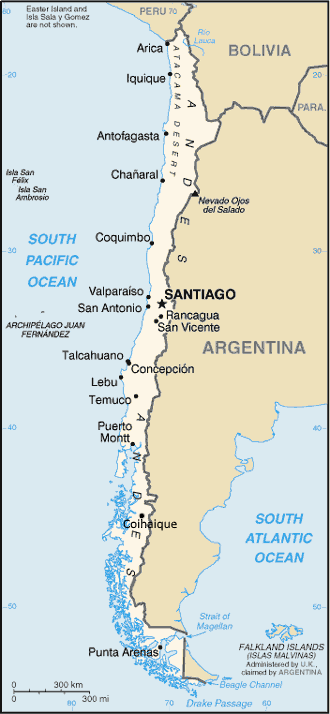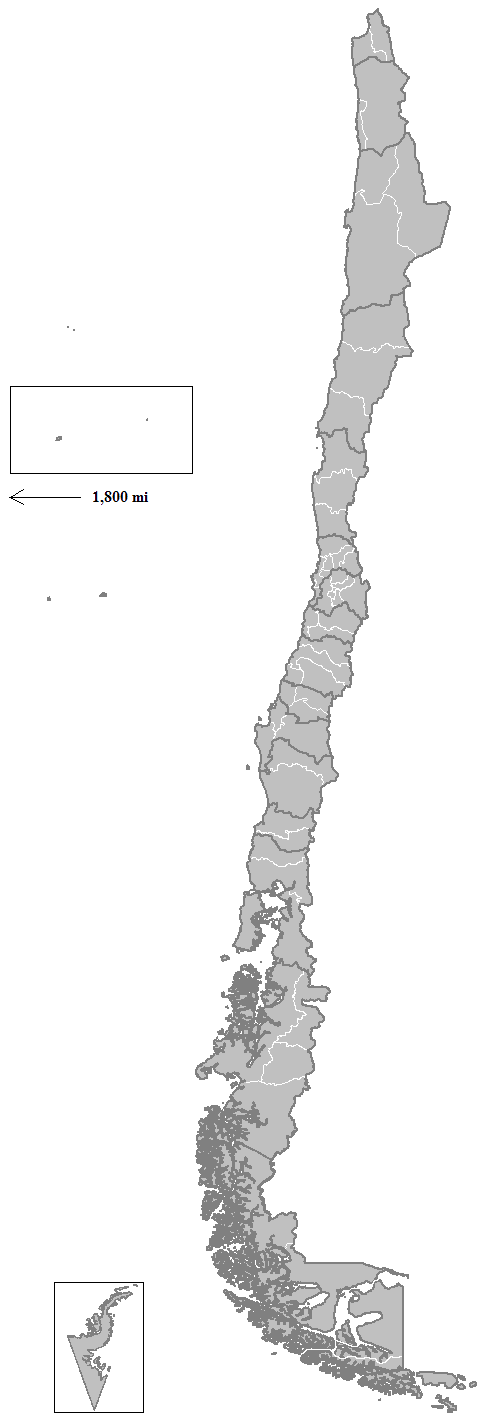|
Natales
Natales (Spanish for "births") is a commune of the Última Esperanza Province in the Magallanes and Antartica Chilena Region of extreme southern Chile. Its capital and only port city is Puerto Natales. Geography The commune's area spans , making it one of the largest communes in Chile, after only Antártica (which is, however, 25 times Natales' size), and larger than eleven of the country's 16 political regions. The Cueva del Milodón Natural Monument lies northwest of Puerto Natales. Demography Its capital and only city, Puerto Natales (2002 population: 16,978), is one of the southernmost settlements in the world. According to the 2002 census of the National Statistics Institute, the Natales commune has 19,116 inhabitants (10,068 men and 9,048 women). Of these, 16,978 (88.8%) lived in urban area of the city and 2,138 (11.2%) in rural areas. The population grew by 10.7% (1,841 persons) between the 1992 and 2002 censuses. The commune comprises 96.3% of the total provincial p ... [...More Info...] [...Related Items...] OR: [Wikipedia] [Google] [Baidu] |
Puerto Natales
Puerto Natales is a city in Chilean Patagonia. It is the capital of both the commune of Natales and the province of Última Esperanza, one of the four provinces that make up the Magallanes and Antartica Chilena Region in the southernmost part of Chile. Puerto Natales is the only city in the province. It is located northwest of Punta Arenas. It is the final passenger port of call for the Navimag ferry sailing from Puerto Montt into the Señoret Channel as well as the primary transit point for travellers to Torres del Paine National Park, Chile. It is located at the opening of Última Esperanza Sound and was originally inhabited by the Kawésqar or Alacaluf people and the Aoniken or Tehuelche people. The first Europeans to visit the area where the city is located were the expeditionaries led by Juan Ladrillero, a Spanish explorer who was looking for the Strait of Magellan's western passage in 1557. The city was settled in the late 19th century by European immigrants, prim ... [...More Info...] [...Related Items...] OR: [Wikipedia] [Google] [Baidu] |
Magallanes And Antartica Chilena Region
The Magallanes Region (), officially the Magallanes y la Antártica Chilena Region () or Magallanes and the Chilean Antarctica Region in English, is one of Chile's 16 first order administrative divisions. It is the southernmost, largest, and second least populated region of Chile. It comprises four provinces: Última Esperanza, Magallanes, Tierra del Fuego, and Antártica Chilena. The region takes its name from the Strait of Magellan which runs through it, which was in turn named after Ferdinand Magellan, the leader of the European expedition that discovered it. Magallanes's geographical features include Torres del Paine, Cape Horn, Tierra del Fuego island, and the Strait of Magellan. It also includes the Antarctic territory claimed by Chile. Despite its large area, much of the land in the region is rugged or closed off for sheep farming, and is unsuitable for settlement. 80% of the population lives in the capital Punta Arenas, a major market city and one of the main hubs f ... [...More Info...] [...Related Items...] OR: [Wikipedia] [Google] [Baidu] |
Última Esperanza Province
Última Esperanza (, meaning "Province of the Last Hope") is one of four provinces in the southern Chilean region of Magallanes and Antártica Chilena. The capital is Puerto Natales and it is named after Última Esperanza Sound. A section of its border with Argentina in the Southern Patagonian Ice Field is under dispute. Administration As a province, Última Esperanza is a second-level administrative division of Chile, which is further divided into two communes (''comunas''): Puerto Natales and Torres del Paine. The province is administered by a presidentially appointed governor. Ana Ester Mayorga Bahamonde was appointed governor by president Sebastián Piñera. Noted features Within this province, the noted Torres del Paine National Park, Cerro Torre and Cerro Chaltén is located, comprising some of the most spectacular mountain peaks of South America. Also part of the biggest non-polar glacier, the Southern Patagonian Ice Field is within Última Esperanza. Cueva del ... [...More Info...] [...Related Items...] OR: [Wikipedia] [Google] [Baidu] |
Administrative Division Of Chile
The administrative division or territorial organization of Chile exemplifies characteristics of a unitary state. State administration is functionally and geographically decentralized, as appropriate for each authority in accordance with the law. For the interior government and administration within the State, the territory of the republic has been divided into 16 regions (''regiones''), 56 provinces (''provincias'') and 346 communes (''comunas'') since the 1970s process of reform, made at the request of the National Commission on Administrative Reform (''Comisión Nacional de la Reforma Administrativa'' or CONARA). State agencies exist to promote the strengthening of its regionalization, equitable development and solidarity between regions, provinces and communes within the nation. Since 2005, the creation, abolition and designation of regions, provinces and communes, the altering of their boundaries, and the establishment of the regional and provincial capitals are part of ... [...More Info...] [...Related Items...] OR: [Wikipedia] [Google] [Baidu] |
Cueva Del Milodón Natural Monument
Cueva del Milodón Natural Monument is a Natural Monument located in the Chilean Patagonia, northwest of Puerto Natales and north of Punta Arenas. The monument is situated along the flanks of Cerro Benitez. It comprises several cave Caves or caverns are natural voids under the Earth's Planetary surface, surface. Caves often form by the weathering of rock and often extend deep underground. Exogene caves are smaller openings that extend a relatively short distance undergrou ...s and a rock formation called ''Silla del Diablo'' (Devil's Chair). The monument includes a cave which is notable for the discovery in 1895 of skin, bones and other parts of a ground sloth called '' Mylodon darwini,'' from which the cave takes its name. It is also part of the End of the World Route, a scenic touristic route. Milodón Cave The largest cave in the monument is the long Milodón Cave. It was discovered in 1895 by Hermann Eberhard, German explorer of Patagonia. He found a ... [...More Info...] [...Related Items...] OR: [Wikipedia] [Google] [Baidu] |
List Of Cities In Chile
This is a list of cities in Chile. A city is defined by Chile's National Statistics Institute (Chile), National Statistics Institute (INE) as an "urban entity"An "urban entity" is defined by Chile's National Statistics Institute (Chile), National Statistics Institute as a concentrated group of dwellings with over 2,000 inhabitants, or between 1,001 and 2,000 inhabitants if 50% or more of its population is economically active, dedicated to Secondary sector of the economy, secondary and/or Tertiary sector of the economy, tertiary activities. Exceptionally, populated centers dedicated to tourism and recreation with over 250 concentrated dwellings and that do not meet the population requirement are considered urban. with more than 5,000 inhabitants. This list is based on a June 2005 report by the INE based on the 2002 census which registered 239 cities across the country. Complete list of cities by region Largest urban agglomerations This list includes conurbations, "absorption ... [...More Info...] [...Related Items...] OR: [Wikipedia] [Google] [Baidu] |
Southernmost Settlements
Southernmost settlements are cities, towns, weather stations or permanent military bases which are farther south than 45th parallel south, latitude 45°S. They are closely related to the Southern Ocean or either the Roaring Forties or Furious Fifties. Antarctic bases are excluded due to not having a permanent population. Unlike the northern hemisphere, where several major metropolitan areas such as Moscow, Harbin, London, Paris, Seattle, and Montreal are all located north of the 45th parallel north, 45°N parallel, the only permanently populated areas south of the 45th parallel south, 45°S parallel are the small and sparsely populated regions of southern Patagonia in South America, the Falkland Islands, and the southernmost tip of New Zealand. Southernmost city ''The southernmost city in the world'' is mainly a slogan used for tourism purposes to attract visitors to a city as well as the tourists headed for Antarctica. ''Ciudad'' (city) is not a legal designation in Chile and Arg ... [...More Info...] [...Related Items...] OR: [Wikipedia] [Google] [Baidu] |
Communes Of Chile
A commune (, ) is the smallest administrative subdivision in Chile. It may contain cities, towns, villages, hamlets as well as rural areas. In highly populated areas, such as Santiago, Valparaíso and Concepción, a conurbation may be broken into several communes. In sparsely populated areas, conversely, a commune may cover a substantial rural area together with several settled areas which could range from hamlets to towns or cities. The term "commune" is ambiguous in English, but the word is commonly used in translation for "comuna", although with some controversy among translators. A comuna is similar to a "county" in Anglo-American usage and practice, and may be more universally understood as a "municipality". Each commune or municipality is governed by a directly elected body known as a municipal council (''concejo municipal'') consisting of a mayor (''alcalde'') and a group of councillors (''concejales''), for a period of four years. The communal civil service admin ... [...More Info...] [...Related Items...] OR: [Wikipedia] [Google] [Baidu] |
Provinces Of Chile
A province is a second-level administrative division in Chile. There are 56 in total. The top-level administrative division in Chile is the regions of Chile, region. There are 16 in total. Each provincial presidential delegation (''delegación presidencial provincial'') is headed by a provincial presidential delegate (''delegado presidencial provincial'') appointed by the President of Chile, President. The governor exercises their powers in accordance with instructions from the regional presidential delegate (''delegado presidencial regional''). The provincial delegate is advised by the Provincial Economic and Social Council (''Consejo Económico y Social Provincial'' or CESPRO). No provincial presidential delegations exist in those provinces where the regional capital is located; its functions were merged with those of the regional presidential delegate. The country's provinces are further divided into 346 communes of Chile, communes which are administered by an alcalde and m ... [...More Info...] [...Related Items...] OR: [Wikipedia] [Google] [Baidu] |
Antártica
Antártica is a Chilean commune in Antártica Chilena Province, Magallanes y la Antártica Chilena Region, which covers all the Chilean Antarctic Territory (the territory in Antarctica claimed by Chile). It ranges from 53°W to 90°W and from the South Pole to 60°S, overlapping the Argentine and British Antarctic claims, and is the largest and least populated commune in Chile, being over 25 times the size of the next largest commune, Natales. It is administered by the Cabo de Hornos municipality in the South American mainland. Antártica was created on 11 July 1961, and was dependent on the Magallanes Province until 1975, when the Antártica Chilena Province was created, making it dependent administratively on Puerto Williams, the province capital. Demographics According to the 2002 census of the National Statistics Institute, Antártica spans an area of and has 130 inhabitants (115 men and 15 women), making the commune an entirely rural area. The population fell by 11.5% ... [...More Info...] [...Related Items...] OR: [Wikipedia] [Google] [Baidu] |
Municipal Council
A municipal council is the legislative body of a municipality or local government area. Depending on the location and classification of the municipality it may be known as a city council, town council, town board, community council, borough council, rural council, village council, board of aldermen, or board of selectmen. Australia Because of the differences in legislation between the states, the exact definition of a city council varies. However, it is generally only those local government areas which have been specifically granted city status (usually on a basis of population) that are entitled to refer to themselves as cities. The official title is "Corporation of the City of ______" or similar. Some of the urban areas of Australia are governed mostly by a single entity (e.g. Brisbane and other Queensland cities), while others may be controlled by a multitude of much smaller city councils. Also, some significant urban areas can be under the jurisdiction of otherwise r ... [...More Info...] [...Related Items...] OR: [Wikipedia] [Google] [Baidu] |



